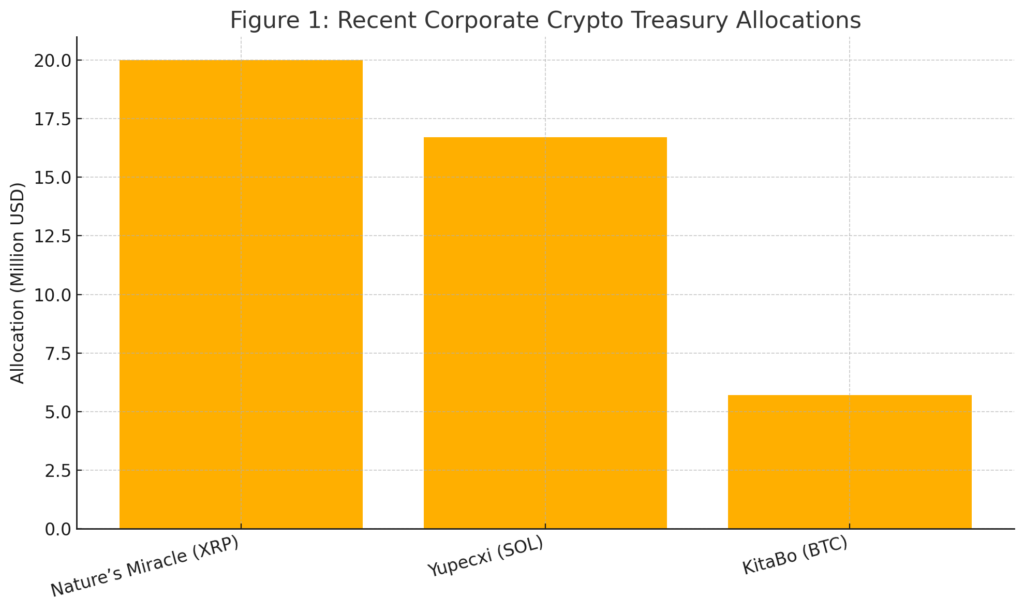
Main Points:
- Traditional firms across diverse sectors are allocating treasury assets to Bitcoin (BTC), XRP, and Solana (SOL).
- Recent notable allocations: Nature’s Miracle ($20M in XRP), Yupecxi ($16.7M in SOL), KitaBo ($5.7M in BTC).
- Corporate heavyweights like MicroStrategy and Tesla continue deepening Bitcoin positions as a hedge.
- Legal, market, and reputational risks mount for firms holding volatile digital assets.
- Altcoins face sharper drawdowns than Bitcoin, accentuating risk of “death spirals.”
- Analysts warn that over-leveraged crypto treasuries may trigger forced selling, driving broader market declines.
- Institutional demand and inflationary pressures are set to fuel further corporate crypto adoption.
Traditional Firms Venture into Crypto Treasuries
In recent months, a growing number of established, publicly traded companies have begun allocating parts of their corporate treasuries to digital assets, signaling a shift in how firms perceive crypto’s role in broad financial strategies. Once confined to niche crypto-native funds, Bitcoin (BTC) has now become a centerpiece for treasury diversification, joined by select altcoins such as XRP and Solana (SOL).
Notably, MicroStrategy—often dubbed the world’s first “Bitcoin treasury company”—continues to expand its Bitcoin holdings, now totaling over 607,770 BTC, valued at roughly $71.8 billion as of late July 2025. Tesla, although having sold portions of its initial stake in 2022, still holds 11,509 BTC valued at about $1.36 billion under new accounting rules, which contributed a 42% unrealized gain in Q2 of 2025, offsetting a 12% drop in automotive revenues.
This institutional embrace reflects several driving factors:
- Inflation Hedge: Corporates view Bitcoin’s capped supply as protection against fiat currency debasement.
- Portfolio Diversification: Digital assets offer low correlation to traditional equities and bonds.
- Investor Demand: Shareholders increasingly pressure firms to pursue crypto exposure.
- Regulatory Clarity: Recent legislative proposals in the U.S., such as the GENIUS Act and CLARITY Act, have reassured risk managers about compliance paths.
Notable Corporate Allocations This Week
| Company | Asset | Allocation |
|---|---|---|
| Nature’s Miracle | XRP | $20 million |
| Yupecxi | SOL | $16.7 million |
| KitaBo | BTC | $5.7 million |
This week alone, three firms spanning agricultural tech, consumer goods manufacturing, and century-old textile recycling announced significant crypto allocations:
- Nature’s Miracle allocated $20 million to XRP as part of a broader altcoin treasury strategy, becoming one of the first major agritech companies to do so.
- Yupecxi, a consumer goods manufacturer, acquired 83,000 SOL tokens, valued at $16.7 million, marking the firm’s debut into blockchain-based financial hedging.
- KitaBo, a publicly listed Japanese textile and recycling company founded nearly 80 years ago, plans to deploy ¥800 million (approximately $5.7 million at an exchange rate of ¥140/USD) into Bitcoin, underscoring the global reach of this trend.
Insertion Point: After the table above, include Figure 1: Recent Corporate Crypto Treasury Allocations Figure 1: Recent Corporate Crypto Treasury Allocations


Risks of Crypto Treasury Strategies
While the potential upsides are clear, analysts and legal experts caution that crypto treasury models carry multifaceted risks:
- Volatility Risk
- Altcoins frequently experience drawdowns up to 90% per market cycle, lacking Bitcoin’s relative price floor.
- Even Bitcoin’s famous bull runs are punctuated by steep corrections exceeding 30%, which can erode treasury valuations rapidly.
- Leverage and “Death Spirals”
- A Breed report from June 2025 warns that highly leveraged crypto treasury firms may face forced selling if prices dip even modestly, triggering a “death spiral” of cascading liquidations and reputational damage.
- Legal and Reputational Risk
- Companies risk class-action lawsuits if crypto allocations fail to meet shareholder expectations or if markets behave unpredictably.
- Regulatory scrutiny—particularly around anti-money laundering and securities laws—can result in fines or operational restrictions.
- Accounting and Reporting Complexities
- Under GAAP, crypto assets are classified as intangible assets, subject to impairment testing, complicating balance sheet management.
- Changes in FASB guidance have recently permitted recognition of unrealized gains, but future rule changes could reverse this benefit.
Altcoins vs. Bitcoin: Divergent Volatility Profiles
Altcoins such as XRP and SOL offer higher potential returns but come with correspondingly higher volatility:
- XRP: Tied to litigation outcomes involving major firms, XRP’s price swings often exceed 50% on legal news alone.
- SOL: While boasting faster transaction speeds, Solana has suffered network outages that have spurred 30–40% price crashes.
- In contrast, Bitcoin’s broader market depth and global liquidity have historically resulted in lower intra-day volatility.
As one community member, Victor, aptly noted on social media:
“Altcoins have no ‘floor’—when the music stops, they stop. Bitcoin has a defined cap and tends to appreciate over time, independent of corporate decisions.”
Future Outlook for Corporate Crypto Strategies
Looking ahead, several trends are likely to shape the evolving landscape:
- Broader Asset Mix: Expect more firms to experiment with tokenized commodities and stablecoins for liquidity management.
- Enhanced Risk Management: Development of bespoke hedging instruments to mitigate crypto volatility in corporate treasuries.
- Regulatory Standardization: Finalization of global accounting and disclosure standards will streamline crypto holdings for public companies.
- Decentralized Finance (DeFi) Integration: Moving beyond holding, treasuries may leverage DeFi protocols for yield generation, albeit with smart contract risks.
Institutional adoption is set to accelerate amid ongoing inflation concerns and continued maturation of the crypto ecosystem. As more CFOs and boards grow comfortable with digital asset frameworks, crypto treasuries could transition from experimental to mainstream components of corporate finance.
Conclusion
The recent wave of traditional corporations allocating treasury assets to Bitcoin, XRP, and Solana underscores the shifting paradigm in corporate finance. While returns can be compelling, the accompanying legal, market, and operational risks demand rigorous governance, clear accounting policies, and robust risk‐management frameworks. By balancing potential rewards against volatility and regulatory uncertainties, forward‐looking firms can leverage digital assets as strategic hedges, unlocking new avenues for portfolio diversification and capital optimization.

